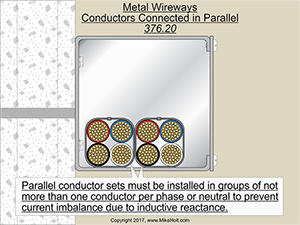
|
Figure 01
|
For EC&M Magazine
By Mike Holt, NEC® Consultant
Here's the follow-up to yesterday's newsletter.
This includes the answers to the questions sent, so you can see how you did.
Note: The answers to these questions are based on the 2017 NEC.
Underlined text indicates a change in the rule for the 2017 NEC.
Q1. What is the NEC definition of a metal wireway?
A1. A sheet metal trough with hinged or removable covers for housing and protecting electric conductors and cable, and in which conductors are placed after the raceway has been installed [376.2]. Š
Author's Comment:
Both metal wireways and nonmetallic wireways are often incorrectly called troughs, auxiliary gutters, auxiliary wireways, or gutters in the field. Wireways and auxiliary gutters are similar in design but one of the main differences is in the application. A wireway is a raceway (Article 100) while an auxiliary gutter [Article 366] is a supplemental enclosure for wiring and isn't considered a raceway.
Q2. What uses are permitted by the Code for metal wireways?
A2. Metal wireways are permitted [376.10]:
(1) Exposed.
(2) In any hazardous locations, as permitted by other articles in the Code.
(3) Wet locations where listed for the purpose.
(4) Unbroken through walls, partitions, and floors.
Author's Comment:
See 501.10(B), 502.10(B), and 504.20 for metal wireways used in hazardous locations.
Q3. What uses are not permitted by the Code for metal wireways?
A3. Metal wireways are not permitted [376.12]:
(1) Where subject to severe physical damage.
(2) Where subject to corrosive environments
Q4. What does the NEC require when conductors are connected in parallel are installed in metal wireways?
A4. Where conductors are installed in parallel as permitted in 310.10(H), the parallel conductor sets must be installed in groups consisting of not more than one conductor per phase or neutral conductor to prevent current imbalance in the paralleled conductors due to inductive reactance. [376.20] Figure 01
Q5. What is the maximum size of conductor that the Code allows to be installed in a wireway?
A5. The maximum size conductor permitted in a wireway isn't permitted to be larger than that for which the wireway is designed [376.21].
Q6. What is the NEC limit on the number of conductors and cables that are allowed to be installed in a wireway?
A6. The maximum number of conductors or cables permitted in a wireway is limited to 20 percent of the cross sectional area of the wireway [376.22(A)]
Author's Comment:
Splices and taps must not fill more than 75 percent of the wiring space at any cross section [376.56].
Q7. What ampacity adjustment factors apply to conductors installed in metal wireways according to the Code?
A7. When more than 30 current carrying conductors are installed in any cross sectional area of the wireway, the conductor ampacity, as listed in Table 310.15(B)(16), must be adjusted per Table 310.15(B)(3)(a). [376.22(B)]. Š
Signaling and motor control conductors between a motor and its starter used only for starting duty aren't considered current carrying for conductor ampacity adjustment.
Q8. What is the Code bending radius requirement for conductors installed in a metal wireway?
A8. Where conductors are bent within a metal wireway, the wireway must be sized to meet the conductor bending space requirements contained in Table 312.6(A), based on one wire per terminal [376.23(A)].
Q9. What are the NEC support requirements for metal wireways?
A9. Wireways must be supported in accordance with (A) and (B) [376.30].
If installed horizontally, metal wireways must be supported at each end and at intervals not exceeding 5 ft [376.30(A)].
If installed vertically, metal wireways must be securely supported at intervals not exceeding 15 ft, with no more than one joint between supports [376.30(B)].
Q10. What does the Code require when installing splices, taps, and power distribution blocks in a metal wireway?
A10. Splices and taps in metal wireways must be accessible, and they must not fill the wireway to more than 75 percent of its cross sectional area [376.56(A)]. Š
Author's Comment:
The maximum number of conductors permitted in a metal wireway is limited to 20 percent of its cross sectional area at any point [376.22(A)].
Power distribution blocks installed in wireways must be listed; if installed on the supply side of the service disconnect, they must be marked suitable for use on the line side of service equipment or equivalent [376.56(B)(1)].
In addition to the wiring space requirements [376.56(A)], the power distribution block must be installed in a metal wireway not smaller than specified in the installation instructions of the power distribution block [376.56(B)(2)].
Wire bending space at the terminals of power distribution blocks must comply with 312.6(B) [376.56(B)(3)].
Power distribution blocks must not have uninsulated exposed live parts in the metal wireway after installation, whether or not the wireway cover is installed [376.56(B)(4)]. Š
Conductors must be installed so that the terminals of the power distribution block aren't obstructed [376.56(B)(5)]. Š
|

